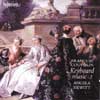Couperin Keyboard Works
Hewitt understands Couperin, but does the piano?
View record and artist detailsRecord and Artist Details
Composer or Director: François Couperin
Genre:
Orchestral
Label: Hyperion
Magazine Review Date: 5/2004
Media Format: CD or Download
Media Runtime: 73
Mastering:
Stereo
DDD
Catalogue Number: CDA67480

Tracks:
| Composition | Artist Credit |
|---|---|
| Livres de clavecin, Book 4, Movement: 21st Ordre (E minor) |
François Couperin, Composer
Angela Hewitt, Piano François Couperin, Composer |
| Livres de clavecin, Book 4, Movement: 24th Ordre (A minor-major) |
François Couperin, Composer
Angela Hewitt, Piano François Couperin, Composer |
| Livres de clavecin, Book 4, Movement: 25th Ordre (E flat-C major-C minor) |
François Couperin, Composer
Angela Hewitt, Piano François Couperin, Composer |
| Livres de clavecin, Book 4, Movement: 26th Ordre (F sharp minor) |
François Couperin, Composer
Angela Hewitt, Piano François Couperin, Composer |
| Livres de clavecin, Book 4, Movement: 27th Ordre (B minor) |
François Couperin, Composer
Angela Hewitt, Piano François Couperin, Composer |
Author: Julie Anne Sadie
The music in the second of Angela Hewitt’s three CDs devoted to Couperin’s pièces de clavecin and performed on the modern piano, is drawn from his Fourth Book, published in 1730, three years before his death. Though cast unusually in three related keys, rather than a single one, and lacking two movements Couperin admits he couldn’t find in time to publish, the opening ordre on the disc, with its French ouverture, intriguing portraiture and evocative imagery neatly encapsulates many of the finest qualities of the collection. Hewitt’s playing is equally representative of her general approach to his music. Her touch is amazingly light, incredibly crisp and alert to the possibilities afforded by the piano. She understands the rhythmic logic of French Baroque music; she has grasped its scale and adapted her playing to it. She is attentive to Couperin’s instructions – ‘La Muse Victorieuse’ is audacious, ‘Les Ombres Errantes’ float languissamment. Hewitt has found her way into Couperin’s world. Shocking as it sounds, the piano itself isn’t really up to the task she has set it. Couperin’s music loses much of its character when transferred to the piano, however skilled its practitioner. By sheer necessity, everything has to be executed in shades of piano; that is not the case on the harpsichord. We may hear Couperin’s counterpoint more clearly, but only because we have lost the shimmering blur of overtones produced by the plucking action of the harpsichord. She evokes Schumann by way of compensation: her carefully judged rubato, legato basses and delicately shaded dynamics confound Baroque expectations. In the aptly titled ‘La Misterieuse’, for example, her application of rubato in the passage alternating between a B flat and a B natural reduces a moment of harmonic piquancy to chromatic dithering.
But one has to admire Hewitt’s skill and attention to detail. Here’s the paradox: on the harpsichord ornaments increase resonance whereas on the piano they are percussive, jarring the music. Couperin would seem to have intended the passage of thirds in the second section of ‘Les Pavots’ (‘Poppies’) to convey a certain narcotic-induced nonchalance; certainly that is the effect on the harpsichord, though sadly not on the piano. All that remains of Couperin’s chimera is an elegantly executed feat of agility. I would love to hear Hewitt play these on the harpsichord.
But one has to admire Hewitt’s skill and attention to detail. Here’s the paradox: on the harpsichord ornaments increase resonance whereas on the piano they are percussive, jarring the music. Couperin would seem to have intended the passage of thirds in the second section of ‘Les Pavots’ (‘Poppies’) to convey a certain narcotic-induced nonchalance; certainly that is the effect on the harpsichord, though sadly not on the piano. All that remains of Couperin’s chimera is an elegantly executed feat of agility. I would love to hear Hewitt play these on the harpsichord.
Discover the world's largest classical music catalogue with Presto Music.

Gramophone Digital Club
- Digital Edition
- Digital Archive
- Reviews Database
- Full website access
From £8.75 / month
Subscribe
Gramophone Full Club
- Print Edition
- Digital Edition
- Digital Archive
- Reviews Database
- Full website access
From £11.00 / month
Subscribe
If you are a library, university or other organisation that would be interested in an institutional subscription to Gramophone please click here for further information.




